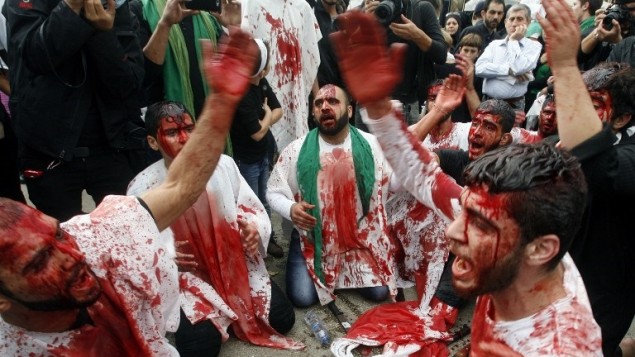With sectarian tensions soaring across the Middle East, Hezbollah’s leader has used the Shi‘ite commemoration of Ashura to deliver a message of conciliation to the nation’s Sunnis—and a word of caution to his fellow Shi‘ites.
On Tuesday, hundreds of thousands of Lebanese Shi‘ites marked the religious occasion amid unprecedented security. Ashura, the most significant date in the Shi‘ite religious calendar, often serves as a powerful and overt motif of communal identity, replete with flags, banners, and rhythmic chanting to commemorate the death of a revered Shi‘ite figure.
Yet with Hezbollah battling Sunni extremists in Syria, and an uptick in Sunni militant attacks on Shi‘ite areas of Lebanon, the militant Shi‘ite movement this year asked followers to tone down some of their commemorative activities in religiously mixed neighborhoods in order to prevent provoking Sunnis.
And on Monday, the eve of Ashura, Sheikh Hassan Nasrallah, Hezbollah’s leader, delivered some warm—and rare—praise for his Sunni political rivals in Lebanon. He hailed the stance of Sunni leaders who had rejected the actions of Sunni militants that recently fought the Lebanese Army in the northern city of Tripoli, saying they had saved the country from a “big disaster.”
“We might have different viewpoints on the regional affairs, and things might reach the extent of rivalry and animosity, but our morals oblige us to take the right and patriotic stance and thank them and appreciate them despite our differences,” Nasrallah said in a rare public appearance.
Ashura commemorates the death in battle of Imam Hussein, grandson of the Prophet Muhammad and a revered figure among Shi‘ites, at Karbala in modern-day Iraq in 680. The ceremony, which gathers together tens of thousands of mourners, makes it a tempting target for extremist Sunnis.
The price of intervening in Syria
In the eyes of most Sunnis across the Middle East, Hezbollah’s intervention into the Syrian conflict has changed its traditional reputation as a champion of anti-Israel resistance. In 2006, after Hezbollah fought the Israeli army to a standstill in southern Lebanon, Nasrallah topped popularity polls in the Arab world. Eight years on, many Sunnis view Hezbollah as a sectarian militia that is defending a Syrian regime dominated by Alawites, a Shi‘ite splinter sect, and backed by Iran.
That Sunni hostility has undermined what Hezbollah sees as its long-standing efforts to promote intra-Muslim unity in order to confront Israel and Western ambitions toward the Middle East.
In his speech Monday, Nasrallah said the conflicts ravaging Syria and Iraq are not sectarian in nature but political, citing examples of battles between rival Sunni factions in the Syrian opposition and the exodus of Christians from Iraq.
“There is an error in diagnosing the nature of the conflict in the region, which is not a Sunni-Shi‘ite conflict,” Nasrallah said. “We, the Shi‘ites, should not be dealing with this conflict as being sectarian. Our battle is not with the Sunnis, but with American hegemony, Israeli schemes, and Takfiris.”
Takfiris are extremist Sunnis who view as apostates all those that do not adhere to their strict version of Islam.
After the toned down commemorations during the nine-day period leading up to Ashura, hundreds of thousands of Shi‘ites dressed in black took to the streets in the southern suburbs of Beirut, a Shi‘ite majority area. Their display was not only of religious observance but also of defiance against the threat of suicide bombers from extremist groups like Islamic State.
Common cause with Yazidis
“What is happening now in Iraq with the Yazidis whose men are being slaughtered and whose women are being sold into slavery by Daesh [Islamic State] is what we have been living with for 1,400 years,” said Hussein, a New York-based Lebanese Shi‘ite attending today’s ritual. “This is what happened to the men and their families at Karbala.”
Iraq’s Yazidis, a Kurdish community that follows an ancient religion that includes some tenets of Christianity and Islam, are being persecuted by IS jihadists who view them as devil worshippers. The United Nations said last month that IS had murdered and enslaved Yazidis in northwest Iraq.

The center of the Ashura commemoration Tuesday was on Hadi Nasrallah Avenue, named after the son of the Hezbollah leader who was killed in 1997 fighting Israeli troops in south Lebanon.
On the roofs of tower blocks overlooking the avenue and side streets, Hezbollah observers and snipers scanned the crowd looking for potential threats. Shi‘ites have been at the receiving end of suicide car bombings, rocket barrages, and roadside bombs over the past 18 months.
Sources close to Hezbollah said the party also had rapid reaction teams on standby to deploy in the event of trouble and even flew some of their pilotless reconnaissance drones over southern Beirut. But the din of the mourning crowds drowning out the distinctive high-pitched whine of their engines. The entrances to southern Beirut were guarded by multiple checkpoints, some manned by the Lebanese Army and others by militants from Hezbollah and the Amal Movement, a rival Shi‘ite political party.
“Are you sure you are not Daesh?” joked a burly Amal militant dressed in a black uniform as he inspected a reporter’s press card and made a throat-cutting gesture with the edge of his hand.
Some of the mourners disguised their apprehension by making jokes about the possibility of IS infiltrating the crowds. But most mourners, some sitting on plastic sheets on the road, ignored the light rain and listened intently to a traditional oration over the loudspeakers in which a sheikh recounts the battle of Karbala in painstaking detail.
As the sheikh reaches the climax of the story and the moment of Imam Hussein’s death, he chokes and weeps, pausing before continuing in a shaky voice. On the street, some men openly sob.
Once the oration is ended, the crowds take to their feet and march, slapping their chests rhythmically and chanting salutations to Imam Hussein.
CSM

Leave a Reply
You must be logged in to post a comment.